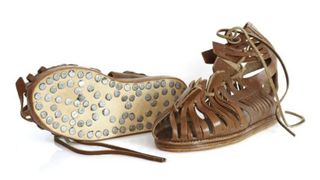2,000-year-old Roman military sandal with nails for traction found in Germany
Archaeologists used X-rays to analyze the remains of a sandal unearthed near a Roman fort in Bavaria.

Archaeologists have discovered the remains of a 2,000-year-old Roman sandal near an ancient military fort in Germany.
Researchers unearthed the military-style footwear while conducting excavation work at a civilian settlement on the outskirts of a Roman military fort near Oberstimm, a city in the state of Bavaria. The settlement would have been occupied sometime between A.D. 60 and 130, according to a translated statement from the Bavarian State Office for Monument Preservation (BLfD).
All that was left of the leather shoe, which researchers analyzed using X-rays, was its sole and some "well-preserved nails."
The X-rays revealed that the shoe was a caliga, a heavy-duty, hobnailed sandal that was part of the uniform issued to Roman legionary soldiers and auxiliaries. The shoe would have been worn while the person was marching, with the nails providing traction. Caligae were protective against blisters and conditions such as trench foot, according to the Trimontium Museum in Scotland. The third Roman emperor — dubbed Caligula, or "little boot" — got his nickname as a boy from his father's soldiers.
However, the Roman army began transitioning away from wearing these sandals by the end of the first century A.D., according to the museum. At that point, Roman soldiers tended to wear enclosed boots known as calcei.
Related: 12 old shoes found in archaeological excavations from around the world

Sandal Remains

X-ray of Sandal
"So-called caligae were mainly worn by Roman soldiers during the Roman Empire," Amira Adaileh, a consultant at the BLfD, said in the statement. "The find makes it clear that the practices, lifestyles and clothing that the Romans brought with them to Bavaria were adopted by the local people."
Sign up for the Live Science daily newsletter now
Get the world’s most fascinating discoveries delivered straight to your inbox.
In addition to the sandals, archaeologists found food scraps, pottery, a sickle and "costume components" at the settlement site, according to the statement.
"Surprise finds such as the shoe sole from Oberstimm make it clear again and again that valuable information is collected even after archaeological excavations have been completed," Mathias Pfeil, curator general at the BLfD, said in the statement.

Jennifer Nalewicki is a Salt Lake City-based journalist whose work has been featured in The New York Times, Smithsonian Magazine, Scientific American, Popular Mechanics and more. She covers several science topics from planet Earth to paleontology and archaeology to health and culture. Prior to freelancing, Jennifer held an Editor role at Time Inc. Jennifer has a bachelor's degree in Journalism from The University of Texas at Austin.
Most Popular


